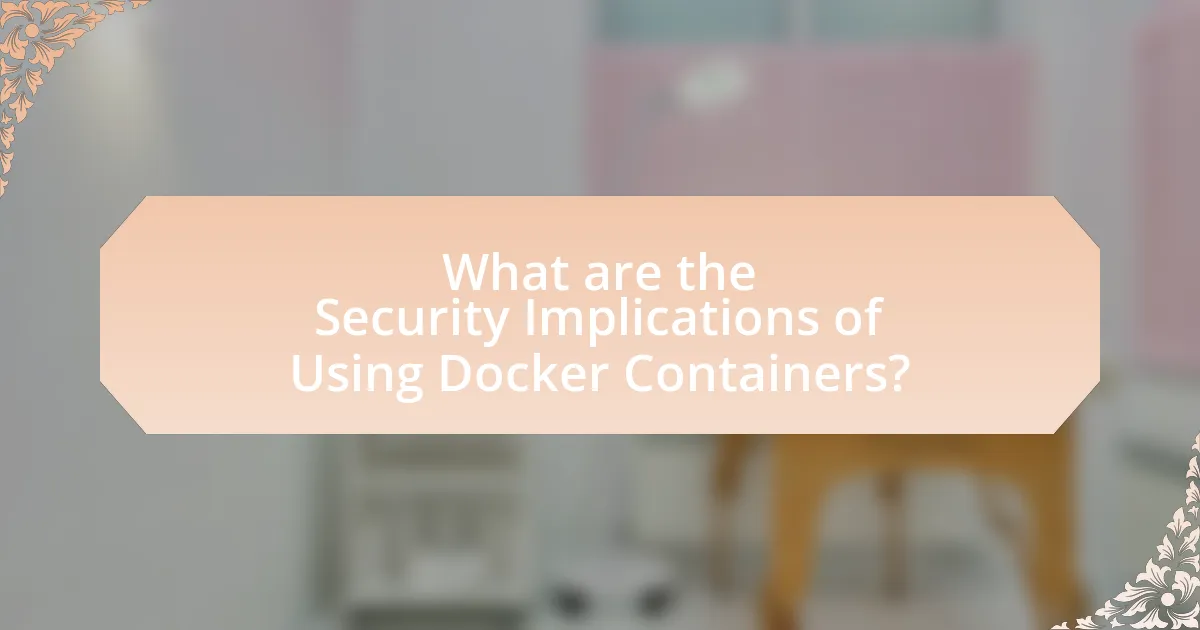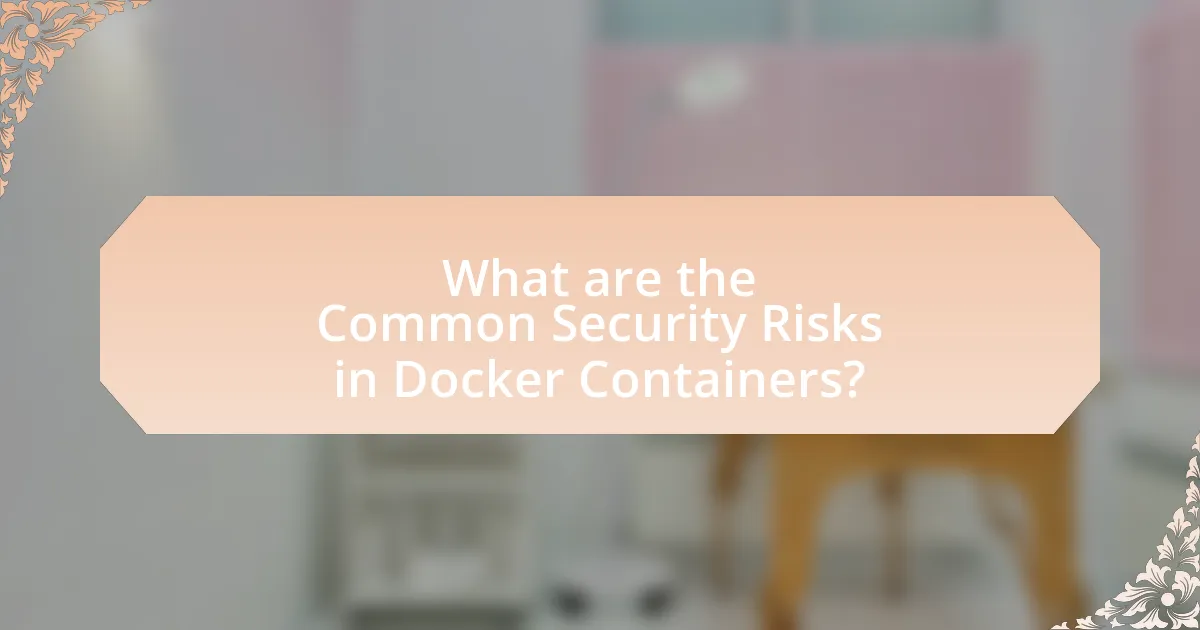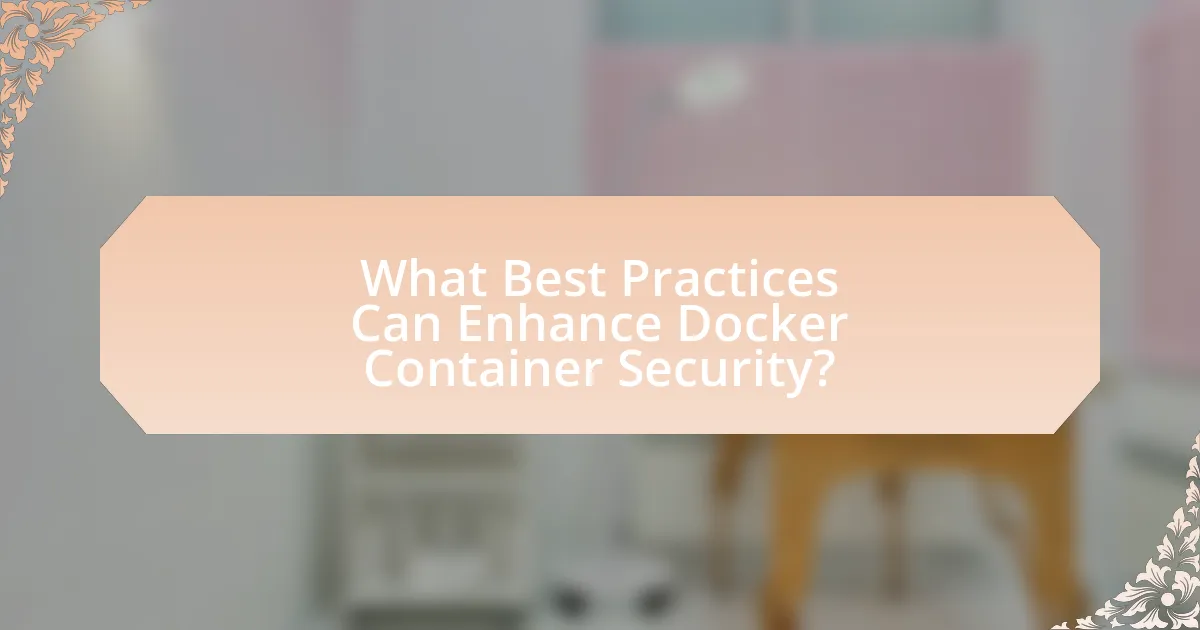The article focuses on the security implications of using Docker containers, highlighting vulnerabilities related to isolation, image integrity, and network exposure. It discusses how Docker containers can enhance security through application isolation while also presenting risks if misconfigured or if insecure images are used. Key security features of Docker, common vulnerabilities, and the importance of understanding Docker security for organizations are examined. Additionally, the article outlines best practices for securing Docker environments, including the use of security scanning tools, regular updates, and effective monitoring strategies to mitigate risks associated with containerized applications.

What are the Security Implications of Using Docker Containers?
The security implications of using Docker containers include vulnerabilities related to isolation, image integrity, and network exposure. Docker containers share the host OS kernel, which can lead to potential breaches if a container is compromised, allowing attackers to access the host system. Additionally, if container images are not properly scanned for vulnerabilities, they may contain malicious code or outdated software, increasing the risk of exploitation. Furthermore, misconfigured network settings can expose containers to unauthorized access, making it crucial to implement strict security measures. According to a report by the Cybersecurity & Infrastructure Security Agency (CISA), container security risks are significant, emphasizing the need for robust security practices in containerized environments.
How do Docker containers enhance or compromise security?
Docker containers enhance security by isolating applications and their dependencies within separate environments, which limits the potential attack surface. This isolation helps prevent vulnerabilities in one container from affecting others or the host system. Additionally, Docker employs features like namespaces and control groups, which further restrict resource access and enhance security boundaries. However, Docker containers can also compromise security if misconfigured, as improper settings may expose sensitive data or allow unauthorized access. For instance, using default configurations or neglecting to implement proper user permissions can lead to security breaches. Therefore, while Docker containers provide significant security benefits through isolation and resource management, they require careful configuration and management to mitigate potential risks.
What are the inherent security features of Docker containers?
Docker containers possess several inherent security features, including isolation, resource control, and image signing. Isolation is achieved through namespaces and control groups, which separate container processes and limit their access to system resources, enhancing security against potential attacks. Resource control allows administrators to set limits on CPU and memory usage, preventing denial-of-service attacks from resource exhaustion. Image signing ensures the integrity and authenticity of container images, allowing users to verify that the images have not been tampered with before deployment. These features collectively contribute to a more secure containerized environment.
What vulnerabilities are commonly associated with Docker containers?
Common vulnerabilities associated with Docker containers include misconfigurations, insecure images, and inadequate isolation. Misconfigurations often arise from improper settings in Dockerfiles or runtime parameters, leading to potential exposure of sensitive data or services. Insecure images can contain vulnerabilities that attackers exploit; for instance, using outdated base images may introduce known security flaws. Inadequate isolation occurs when containers share the host kernel, which can allow a compromised container to affect others or the host system itself. According to the 2021 Docker Security Report, 60% of organizations reported security incidents related to container misconfigurations, highlighting the prevalence of these vulnerabilities.
Why is understanding Docker security important for organizations?
Understanding Docker security is crucial for organizations because it directly impacts the integrity and confidentiality of their applications and data. Docker containers can introduce vulnerabilities if not properly secured, leading to potential breaches and data loss. For instance, a report by the Cybersecurity and Infrastructure Security Agency (CISA) highlighted that misconfigured containers were a common attack vector, emphasizing the need for robust security practices. Organizations that prioritize Docker security can mitigate risks, ensure compliance with regulations, and maintain customer trust by safeguarding sensitive information.
How can security breaches in Docker containers impact businesses?
Security breaches in Docker containers can significantly impact businesses by exposing sensitive data, leading to financial losses and reputational damage. When a breach occurs, attackers can gain unauthorized access to the host system, potentially compromising customer information and intellectual property. According to a report by IBM, the average cost of a data breach in 2021 was $4.24 million, highlighting the financial repercussions businesses face. Furthermore, breaches can result in downtime, affecting operational efficiency and customer trust. The 2020 Verizon Data Breach Investigations Report indicated that 30% of breaches involved web applications, which often utilize containerized environments, underscoring the vulnerability of Docker containers.
What are the regulatory implications of Docker security failures?
Docker security failures can lead to significant regulatory implications, including potential violations of data protection laws such as the General Data Protection Regulation (GDPR) and the Health Insurance Portability and Accountability Act (HIPAA). These regulations mandate strict data security measures, and breaches resulting from Docker vulnerabilities could result in hefty fines, legal actions, and reputational damage for organizations. For instance, under GDPR, organizations can face fines up to 4% of their annual global turnover for non-compliance, emphasizing the critical need for robust security practices in containerized environments.

What are the Common Security Risks in Docker Containers?
Common security risks in Docker containers include vulnerabilities in container images, misconfigurations, and inadequate isolation between containers. Vulnerabilities in container images arise when outdated or insecure base images are used, potentially allowing attackers to exploit known flaws. Misconfigurations often occur when security settings are not properly applied, leading to excessive permissions or exposure of sensitive data. Inadequate isolation can result from shared kernel resources, making it possible for one compromised container to affect others. According to a report by the Cybersecurity and Infrastructure Security Agency (CISA), these risks can lead to unauthorized access, data breaches, and service disruptions, highlighting the importance of implementing robust security practices in container management.
What types of threats do Docker containers face?
Docker containers face several types of threats, including unauthorized access, image vulnerabilities, and insecure configurations. Unauthorized access can occur when attackers exploit weak authentication mechanisms or misconfigured access controls, allowing them to gain control over the container environment. Image vulnerabilities arise from using outdated or unverified container images, which may contain known security flaws that can be exploited. Insecure configurations, such as running containers with excessive privileges or exposing unnecessary ports, can also lead to increased risk of attacks. According to a report by the Cybersecurity and Infrastructure Security Agency (CISA), these vulnerabilities can lead to data breaches and service disruptions, highlighting the importance of securing Docker containers effectively.
How do misconfigurations lead to security risks in Docker?
Misconfigurations in Docker lead to security risks by exposing containers to vulnerabilities that can be exploited by attackers. For instance, improper settings in Dockerfiles, such as using overly permissive permissions or failing to limit container capabilities, can allow unauthorized access to sensitive data or system resources. A study by the Cybersecurity and Infrastructure Security Agency (CISA) highlights that 60% of container security incidents stem from misconfigurations, emphasizing the critical need for proper configuration management. Additionally, misconfigured network settings can enable attackers to intercept traffic or gain unauthorized access to containerized applications, further increasing the risk of data breaches.
What role do untrusted images play in Docker security vulnerabilities?
Untrusted images significantly increase Docker security vulnerabilities by introducing malicious code or insecure configurations. These images, often sourced from unverified repositories, can contain backdoors, malware, or outdated software with known vulnerabilities. For instance, a study by the Cybersecurity and Infrastructure Security Agency (CISA) highlighted that 80% of public Docker images contain vulnerabilities, emphasizing the risks associated with using untrusted sources. Consequently, deploying applications using these images can lead to data breaches, unauthorized access, and compromised system integrity.
How can container isolation affect security?
Container isolation significantly enhances security by creating separate environments for applications, which limits the potential impact of security breaches. This isolation ensures that if one container is compromised, the attacker cannot easily access or affect other containers or the host system. For instance, Docker uses namespaces and control groups to enforce this separation, effectively reducing the attack surface. Research indicates that vulnerabilities in containerized applications can lead to host system breaches if isolation is not properly implemented, highlighting the importance of robust container isolation mechanisms in maintaining overall security.
What are the limitations of Docker’s isolation mechanisms?
Docker’s isolation mechanisms have several limitations, primarily related to security and resource management. One significant limitation is that Docker containers share the host operating system’s kernel, which can lead to vulnerabilities if a container escapes its isolation. This shared kernel architecture means that a flaw in the kernel can potentially compromise all containers running on that host. Additionally, Docker’s default configurations may not enforce strict isolation, allowing containers to access each other’s resources if not properly configured. Furthermore, the lack of complete separation between containers can lead to issues such as privilege escalation, where a malicious actor could gain elevated access to the host system. These limitations highlight the need for careful configuration and additional security measures when deploying Docker containers in production environments.
How does the host system’s security influence Docker container security?
The host system’s security significantly influences Docker container security by determining the overall security posture and vulnerability exposure of the containers. If the host system is compromised, attackers can gain access to the Docker daemon, which manages container operations, potentially allowing them to manipulate or escape from containers. For instance, vulnerabilities in the Linux kernel or misconfigurations in the host can lead to privilege escalation, enabling unauthorized access to sensitive data or resources within containers. Research indicates that 60% of container security incidents stem from vulnerabilities in the host environment, highlighting the critical need for robust host security measures to protect containerized applications effectively.

What Best Practices Can Enhance Docker Container Security?
To enhance Docker container security, implement the principle of least privilege by ensuring containers run with the minimum necessary permissions. This practice limits the potential damage from a compromised container, as it restricts access to system resources and sensitive data. Additionally, regularly update Docker images to include the latest security patches, as vulnerabilities in outdated images can be exploited. According to a report by the National Institute of Standards and Technology (NIST), keeping software up to date is crucial for mitigating security risks. Furthermore, utilize Docker’s built-in security features, such as user namespaces and seccomp profiles, to isolate containers and restrict their capabilities. These measures collectively strengthen the security posture of Docker containers against various threats.
How can organizations secure their Docker environments effectively?
Organizations can secure their Docker environments effectively by implementing a multi-layered security approach that includes image scanning, access controls, and runtime protection. Image scanning helps identify vulnerabilities in container images before deployment, ensuring that only secure images are used. Access controls, such as role-based access control (RBAC), restrict permissions to only those users who need them, minimizing the risk of unauthorized access. Runtime protection involves monitoring container behavior and enforcing security policies to detect and respond to anomalies in real-time. According to a report by the Cloud Native Computing Foundation, 90% of organizations that implemented these practices reported a significant reduction in security incidents related to containerized applications.
What are the recommended practices for managing Docker images?
The recommended practices for managing Docker images include regularly scanning images for vulnerabilities, using minimal base images, tagging images appropriately, and implementing a robust image lifecycle management strategy. Regular vulnerability scanning helps identify security issues early, while minimal base images reduce the attack surface by including only necessary components. Proper tagging aids in version control and tracking, ensuring that the correct images are deployed. A well-defined image lifecycle management strategy, which includes cleaning up unused images and maintaining a repository of trusted images, enhances security and efficiency in Docker image management.
How can regular updates and patching improve Docker security?
Regular updates and patching significantly enhance Docker security by addressing vulnerabilities and ensuring that the software is equipped with the latest security features. Vulnerabilities in Docker images and the underlying operating system can be exploited by attackers; thus, timely updates mitigate these risks by fixing known security flaws. For instance, the National Vulnerability Database (NVD) regularly catalogs vulnerabilities, and many of these are resolved through updates. By applying patches, organizations can reduce their attack surface and protect against exploits that target outdated software components.
What tools and resources are available for Docker security?
Docker security can be enhanced using various tools and resources designed to identify vulnerabilities and enforce best practices. Key tools include Docker Bench for Security, which audits Docker containers against security best practices, and Clair, a static analysis tool for container vulnerabilities. Additionally, Aqua Security and Sysdig Secure provide comprehensive security solutions that include runtime protection and vulnerability scanning. Resources such as the Docker Security Best Practices guide and the CIS Docker Benchmark offer essential guidelines for securing Docker environments. These tools and resources collectively help organizations mitigate risks associated with containerized applications.
Which security scanning tools are most effective for Docker containers?
The most effective security scanning tools for Docker containers include Aqua Security, Twistlock (now part of Palo Alto Networks), and Clair. Aqua Security provides comprehensive vulnerability scanning and compliance checks, while Twistlock offers runtime protection and vulnerability management. Clair, an open-source project, integrates with container registries to analyze images for known vulnerabilities. These tools are widely recognized in the industry for their ability to identify security risks and ensure compliance within Docker environments.
How can organizations implement security monitoring for Docker environments?
Organizations can implement security monitoring for Docker environments by utilizing a combination of container security tools, logging mechanisms, and continuous monitoring practices. Specifically, deploying tools like Aqua Security, Sysdig, or Twistlock enables real-time vulnerability scanning and compliance checks for Docker images and containers. Additionally, integrating logging solutions such as ELK Stack (Elasticsearch, Logstash, Kibana) or Fluentd allows organizations to collect and analyze logs from Docker containers, providing insights into security events and anomalies. Continuous monitoring practices, including setting up alerts for suspicious activities and regularly reviewing access controls, further enhance the security posture of Docker environments. These methods collectively ensure that organizations can detect, respond to, and mitigate security threats effectively within their containerized applications.
What are the key takeaways for securing Docker containers?
To secure Docker containers, implement the principle of least privilege by limiting container permissions and using user namespaces. This minimizes the risk of unauthorized access and potential exploitation. Additionally, regularly update Docker images and use trusted base images to reduce vulnerabilities. According to the National Institute of Standards and Technology (NIST), maintaining up-to-date software is crucial for mitigating security risks. Employing security scanning tools to identify vulnerabilities in images before deployment further enhances security. The Center for Internet Security (CIS) provides benchmarks that recommend specific configurations to harden Docker installations, reinforcing the importance of following established security guidelines.